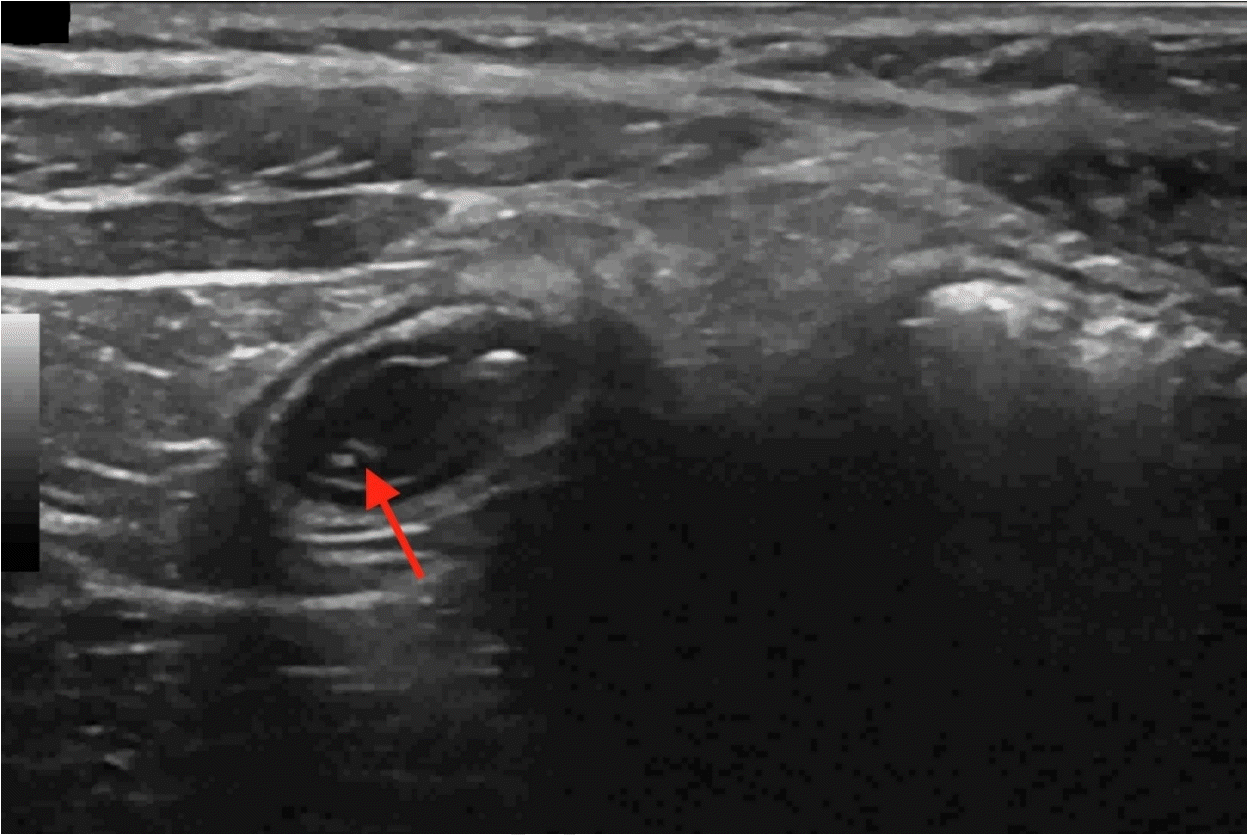Abstract
This case report discusses a school-aged boy who presented to the emergency department with diffuse abdominal pain and fever. After investigation, he was found to have Enterobius vermicularis infestation of the appendix without appendicitis. The novelty of this case is the video clip of a live worm-like finding on ultrasound in the boy. The video for this case serves as a reminder for emergency physicians or pediatricians to consider parasitic etiologies in children with abdominal pain, absent some of the classic manifestations like perianal pruritis.
Enterobius vermicularis, colloquially referred to as a pinworm, is a common parasitic etiology found in children. They are transmitted via the fecal-oral route. Ingested eggs travel to the duodenum where they develop and undergo sexual maturation. Adult parasites reside in the cecum, and migrate to the anus at night where they deposit eggs. The classic presenting manifestation in children is nocturnal perianal pruritis, which is how the parasites can continue their life cycle1). Given the life cycle of the intestinal helminth, it becomes apparent how the adult parasites can easily migrate from their home in the cecum to the appendiceal lumen. Whether the presence of appendicitis is caused by the parasites is up for debate. This study was exempted from ethical approval by the institutional review board of Brooke Army Medical Center (IRB no. not applicable).
A previously healthy 9-year-old boy presented to the emergency department with abdominal pain that started about 24 hours prior. The pain was intermittent, diffuse, achy, and progressively worsened to the point that he had difficulty walking due to the pain. He was afebrile. He had 2 episodes of non-bloody and non-bilious emesis, 1 episode of non-bloody diarrhea, and anorexia to solid foods. He denied upper respiratory symptoms, urinary symptoms or trauma. There were no sick contacts with a similar gastrointestinal illness. The boy did not have a history of constipation.
The initial vital signs were as follows: blood pressure, 101/74 mmHg; heart rate, 136 beats per minute; respiratory rate, 32 breaths per minute; temperature, 38.2°C; and oxyhemoglobin saturation, 100%. He was visibly uncomfortable, but not writhing in pain. His physical examination was notable for mild to moderate diffuse abdominal tenderness with negative heel tap and jump tests, and there were no peritoneal irritation signs. His testicular exam was normal. Laboratory evaluation showed a leukocyte count of 13.5×103/μL with 88% neutrophils. The remainder of the laboratory findings, such as complete blood count and comprehensive metabolic panel, were within normal limits.
Subsequently, an abdominal ultrasound (Logiq E9; GE Healthcare, Chicago, IL) showed evidence of appendicitis. The presence of parasites in the appendiceal lumen with evidence of appendicitis in this clinical setting was presumed to be E. vermicularis infestation-associated appendicitis or a possible coincidence of infestation and appendicitis (Fig. 1; see video, Appendix 1, https://doi.org/10.22470/pemj.2022.00430). On further history taking, the boy denied perianal pruritis, the presence of parasites, and his mother denied the symptoms in his siblings. He underwent a laparoscopic appendectomy on day 2, and received a dose of albendazole postoperatively, as well as a prescription for additional doses to be taken in the following 2 weeks. The operation was uncomplicated, and the boy was discharged on day 2.
The pathological specimen showed the absence of contents obstructing the appendix and of any parasitic evidence, and was described as the normal appendix. Presumably, the live parasite migrated out of the appendiceal lumen prior to the operation. In a review of this case, the interpreting radiologist stated that the initial sonographic findings suggestive of appendicitis were a false positivity.
According to a recent systematic review covering 59 articles on appendicitis with a total of 103,195 appendiceal tissue samples, the pooled prevalence of E. vermicularis infestation was 4% (95% confidence interval, 2%-6%), making it a rare phenomenon2). The novel aspect of this case is that the ultrasound showed a live, moving worm-like finding in the appendix of a boy without a clinical suspicion of parasitic infestation (Appendix 1).
The etiology of appendicitis is thought to be due to an obstruction of the appendiceal lumen, and includes fecalith, calculi, lymphoid hyperplasia, infectious processes, undigested food, other foreign materials, tumors, and parasites. This case demonstrates a false positive ultrasound for appendicitis in a boy with radiographic evidence of appendiceal E. vermicularis infestation. This case with the video clip of the live, worm-like finding on the ultrasound serves as a reminder for emergency physicians or pediatricians to consider parasitic etiologies in children with diffuse abdominal pain.
ACKNOWLEDGMENTS
The authors thank Dr. Brian Bates for reviewing the manuscript. The views expressed herein are those of the authors, and do not reflect the official policy or position of Brooke Army Medical Center, the U.S. Army Medical Department, the U.S. Army Office of the Surgeon General, the Department of the Army, the Department of the Air Force, the Department of Defense or the U.S. Government.
Fig. 1.
A still image of the abdominal ultrasound. It was performed by an ultrasound technician, and read by a pediatric radiologist. The appendix measured up to 8 mm in diameter. There was mildly increased echogenicity of the periappendiceal fat and no evidence of perforation. These findings support a diagnosis of appendicitis. Within the lumen, there is a tiny live worm-like finding (arrow) presumed to be a parasite by the radiologist.

Appendix
Appendix 1.
In the video, the live worm-like finding is moving in the bottom left portion of the appendiceal lumen (https://doi.org/10.22470/pemj.2022.00430).
pemj-2022-00430-1.webm




 PDF
PDF Citation
Citation Print
Print



 XML Download
XML Download